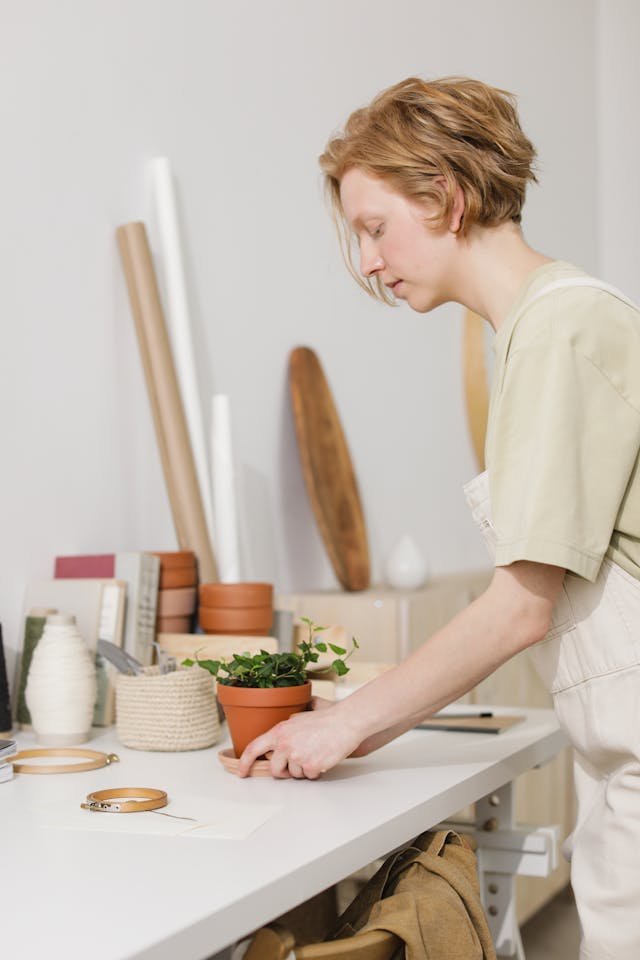Things to Get Rid of for a Clutter-Free Home
Feeling overwhelmed by the clutter around you? You’re not alone. Many people find themselves surrounded by items they don’t really need.
Getting rid of unnecessary things can simplify your life and create a more serene living space. By tackling clutter step by step, you can make your home feel more organized and inviting.
Imagine opening your closet and finding everything you need at a glance or having a kitchen where every surface is tidy and functional. It’s closer than you think when you start by clearing out those old clothes you haven’t worn in years, expired beauty products, or gadgets you never use. You won’t miss them, and you’ll gain valuable space and peace of mind.
Your home should be a sanctuary, not a storage unit. By letting go of redundant items like old cords or obsolete electronics, you can focus on what truly brings you joy and utility. This process isn’t just about making room; it’s about making room for a lifestyle that prioritizes happiness and efficiency.
Identifying Clutter
Determining what constitutes clutter requires thoughtful consideration of various factors. You’ll need to recognize different types of clutter, evaluate how often you use specific items, and confront any emotional attachments you might have to them.
Types of Clutter
Clutter can take many forms and understanding these types can help you tackle them effectively.
Physical clutter, often the most noticeable, includes unnecessary items that occupy your living space: outdated electronics, stacks of magazines, or expired beauty products. Another category is digital clutter, like unused apps or old files on your devices. There’s also emotional clutter, which consists of things you hold onto for sentimental reasons, such as gifts or souvenirs that no longer serve a purpose but carry emotional weight. Identifying these categories makes it easier to know what can be discarded or repurposed.
Assessing Item Usage
One practical approach for identifying clutter is to evaluate how often you actually use certain items.
You might start by asking yourself how frequently you use something. Is it seasonal, weekly, or was it last used over a year ago? A common method is the one-year rule: if you haven’t used it in the last year, it may be time to let it go. Consider the item’s relevance to your current lifestyle as well.
Tools like weekly planners or usage logs can be helpful to track activity and make informed decisions about keeping or discarding items. This method can significantly free up space and energy in your life.
Emotional Attachment and Letting Go
Letting go of items with sentimental value can be challenging but sometimes necessary for effective decluttering. Emotional bonds often turn objects into clutter, particularly when they no longer bring you joy or serve a purpose.
Ask yourself if the memory associated with the item is more important than the item itself. Try setting aside a specific time to go through these belongings, allowing yourself to reminisce before deciding. Photographing sentimental items before parting with them can be a way to preserve memories without keeping the physical object. Building awareness and acceptance around emotional ties empowers you to make choices that support a clutter-free home.
Organizing Your Space
Organizing your space involves a thoughtful approach to sorting your belongings and finding effective storage solutions. It’s about making your space functional and enjoyable without unnecessary clutter hampering your daily life.
Sorting Your Belongings
Start by categorizing items into groups such as keep, donate, and discard. This helps in making the process less overwhelming. For sentimental items, consider whether they have a practical use or if they can be preserved in a different form, like digital photos.
A timer can be your best friend by setting it for short intervals, allowing you to focus without burning out. It’s about making small, consistent choices daily, a strategy that makes decluttering less daunting.
Evaluate each item’s significance and function in your home. If you haven’t used something in the past year, it might be time to let it go. This process enables a clearer, more organized environment. Approach each task step by step and allot specific times to address different areas to maintain focus and motivation.
Storage Solutions
Storage solutions can transform a cluttered space into an organized haven. Use multi-functional furniture like ottomans with storage or beds with drawers underneath to maximize space.
Consider clear bins and labels, making it easier to find things when needed. Shelving can help utilize vertical spaces that might otherwise go unused.
For smaller areas, hanging organizers or collapsible baskets can provide storage without taking up valuable ground space. Drawer dividers are another great way to keep things tidy inside closed spaces. It’s about finding creative methods to keep your belongings accessible yet out of sight, maintaining both the beauty and functionality of your living area.
Disposing of Unwanted Items
When you’re ready to clear out clutter, it’s essential to think about the best ways to dispose of items responsibly. This includes considering recycling, donation, and environmentally-friendly methods.
Recycling Options
Recycling helps in reducing landfill waste and conserving resources. You should start by checking your local regulations to see which items can be recycled curbside.
Commonly accepted recyclables include plastics, glass, paper, and metal.
For electronics or hazardous waste like batteries, you might need special programs offered by your city. Some towns have recycling centers that accept a broader range of materials. It may be helpful to organize a specific drop-off day each month.
Consider using online resources or apps to locate nearby e-waste and recycling drop-off locations. These platforms can offer advice on sorting and preparing items for recycling, ensuring that materials are disposed of properly and efficiently.
Selling and Donating
If you have items that are still usable, selling or donating might be a great choice.
Consider hosting a garage sale or using online marketplaces like eBay or Facebook Marketplace to reach potential buyers. Not only does this help declutter your home, but it can also put some extra cash in your pocket.
Donating to charities or thrift stores like Goodwill is another excellent option. You can clear your home and support local organizations at the same time. Ensure items are in good condition before donating. Organizations often have guidelines on what items they can accept, so check these before you donate.
You can swap clothing with friends. This could turn into a fun social event and help you get rid of unwanted outfits.
Eco-Friendly Disposal
For items that can’t be recycled or donated, eco-friendly disposal methods are crucial.
Begin by categorizing these items, as suggested by Family Handyman, to streamline the process. Composting is a practical solution for organic waste, reducing landfill impact and enriching your garden.
For discarding medications, some pharmacies or city services offer take-back programs to dispose of them safely. If you’re getting rid of old electronics, many areas offer e-waste collection days. Always follow community guidelines to ensure safe and environmentally friendly disposal.
Maintaining a Clutter-Free Environment
Keeping your home free from clutter involves cultivating mindful habits and establishing efficient cleaning routines. These steps help maintain order and create a more relaxing atmosphere.
Habits to Adopt
Incorporate small, consistent habits into your daily routine to keep clutter at bay. Spend a few minutes each day returning items to their designated spots. This habit helps prevent piles from forming and your space from becoming overwhelming.
Adopt a “one in, one out” rule. For each new item you bring home, decide on something to donate, sell, or discard. This prevents accumulation and helps maintain balance. Opt to regularly assess belongings and let go of anything that’s no longer useful.
Focus on spaces that tend to attract clutter, like kitchen counters or entryway tables. Pay attention to these areas daily to manage any potential buildup. Keeping these habits in mind makes maintaining a clutter-free home much easier.
Regular Cleaning Routines
Beyond daily habits, establish a regular cleaning schedule to address potential clutter. Dedicate specific times each week to tackle areas that easily collect mess, like closets or bathroom cabinets. Consistently sorting through these spots keeps accumulation under control.
Use a checklist to simplify your cleaning routine. For example, once a month, review items in your pantry to discard expired foods, as recommended in the Decluttering Checklist for Minimalists. Similarly, evaluate wardrobes seasonally and remove unworn or outdated clothing.
Consider involving family members in these routines to distribute the workload. Assign tasks such as tidying personal spaces or maintaining shared areas. Involving everyone helps encourage responsibility and ensures the entire home remains a pleasant, clutter-free environment.
Mindful Shopping Practices
Mindful shopping helps you make intentional purchases and reduces clutter. By focusing on avoiding impulse buys and choosing quality over quantity, you can spend your money wisely and bring in items that truly enhance your life.
Avoiding Impulse Buys
Impulse purchases often lead to unwanted clutter and regret. To avoid this, consider implementing a cooling-off period. This involves waiting 24 hours before buying non-essential items, giving you time to reflect on whether the purchase is necessary.
Creating a shopping list and sticking to it can also help you stay focused. This list becomes your guide, preventing spontaneous buying. Additionally, setting a clear budget limits your spending, providing a boundary within which you can operate comfortably and responsibly. Practicing these strategies allows you to control your shopping habits and avoid unnecessary purchases, leading to a more intentional lifestyle.
Investing in Quality Over Quantity
When shopping, it’s crucial to prioritize quality instead of quantity. Investing in high-quality items, although potentially more expensive upfront, often saves you money over time.
These purchases last longer and work better, rewarding careful consideration. Focus on brands or products known for their durability and good craftsmanship.
Research reviews and materials to ensure what you buy will withstand regular use. Opt for timeless designs that match various styles to maximize versatility.
By emphasizing the longevity and utility of your purchases, you cultivate a collection of items that serve you well. This reduces the need for frequent replacements and ultimately results in a more sustainable shopping approach.


